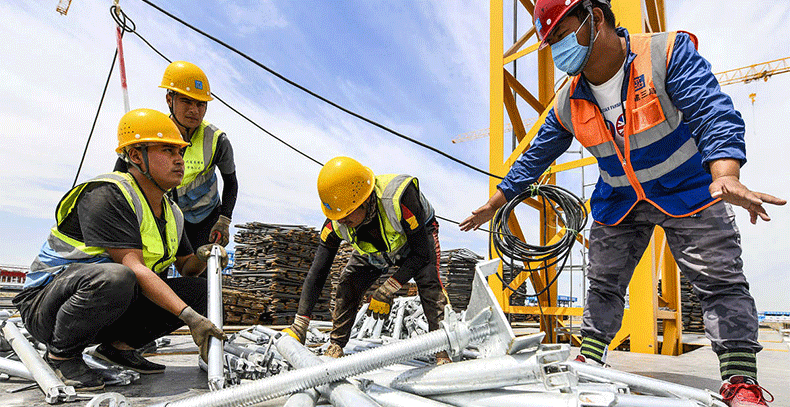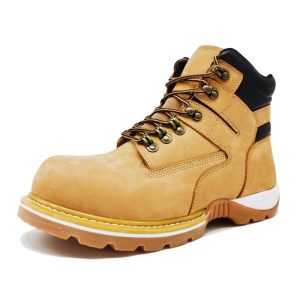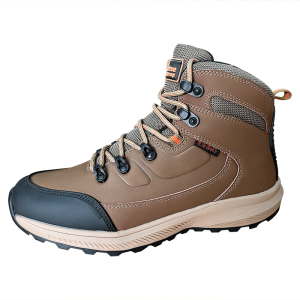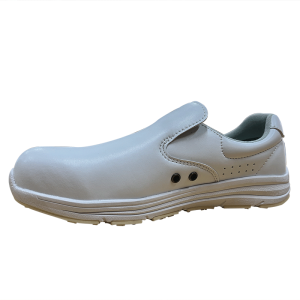The construction site is a high-risk working environment. Workers need to face various dangers on the construction site, such as falling, stabbing, electric shock, etc. Therefore, choosing the right safety shoes is crucial to protecting workers’ safety. There are several types of safety shoes that are better choices on construction sites.
The first type is steel toe safety shoes.
Steel-toe safety shoes are the most common type of safety shoes. Their toe parts are made of steel, which can effectively prevent workers’ feet from being punctured or crushed by objects. The advantage of steel-toed safety shoes is that they are durable, strong and can provide better protection. They are suitable for heavy-duty work on construction sites, such as carrying heavy objects, operating machinery, etc.
The second type is anti-slip safety shoes.
There are often slippery surfaces on construction sites, such as oil stains, puddles, etc., which pose a threat to the safety of workers. Therefore, it is very important to choose safety shoes with good anti-slip properties.
Anti-slip safety shoes are usually made of rubber or polyurethane materials, which have good anti-slip properties and can effectively reduce the risk of slipping. They are suitable for work on construction sites that require frequent walking and standing, such as inspecting construction sites, on-site inspections, etc.
The third type is insulated safety shoes.
On construction sites, sometimes workers need to come into contact with live equipment such as cables and wires, so they need to choose safety shoes with insulating properties.
Insulated safety shoes are made of insulating materials, which can effectively isolate current and prevent electric shock accidents. They are suitable for electrical work on construction sites, such as cable laying, electrical maintenance, etc.
In addition to the above types of safety shoes, there is also a new type of safety shoes worth mentioning, which are non-metallic safety shoes.
Non-metallic safety shoes are made of non-metallic materials, such as fiber composite materials, carbon fiber materials, etc. Non-metal safety shoes have more advantages than traditional metal safety shoes.
First, non-metallic safety shoes are lighter.
The use of non-metallic materials reduces the overall weight of the shoe, making it more comfortable for workers to wear for long periods of time.
Secondly, non-metallic safety shoes are more flexible.
Non-metallic materials are generally more flexible than metal and can better adapt to the shape of the foot, providing better comfort and flexibility.
Again, non-metallic safety shoes are more wear-resistant.
Non-metallic materials have high wear resistance, can maintain a longer service life in harsh working environments, and reduce the economic burden on workers.
Finally, non-metallic safety shoes have insulating properties.
Non-metallic materials usually have good insulation properties and can effectively isolate external factors such as cold, high temperature and current, providing better safety protection.
In short, the choice of safety shoes on construction sites is very important. Steel-toe safety shoes, non-slip safety shoes, insulated safety shoes and non-metallic safety shoes are all suitable safety shoe options for construction sites.
When choosing safety shoes, you should also consider the following factors:
Comfort:
Work on construction sites often requires standing and walking for long periods of time, so it is very important to choose comfortable safety shoes. Comfortable safety shoes should have suitable soles and insoles that provide adequate support and cushioning to reduce foot fatigue and discomfort.
Breathability:
Construction sites are usually a hot and humid environment. Choosing safety shoes with good breathability can help feet stay dry and comfortable. Safety shoes with good breathability can eliminate sweat from the feet and reduce odor and bacterial growth.
Durability:
On construction sites, safety shoes have to withstand long-term use and various harsh environments, so it is very important to choose durable safety shoes. Durable safety shoes are usually made of high-quality materials with good wear and pressure resistance.
Waterproof:
There may be puddles, mud and other humid environments on construction sites. Choosing safety shoes with waterproof properties can keep your feet dry and comfortable. Waterproof safety shoes are usually made of waterproof materials that can effectively prevent moisture penetration.
Comply with standards:
When choosing safety shoes, you should also ensure that they comply with relevant safety standards. Different countries and regions may have different safety standards. It is recommended to choose safety shoes that comply with local standards to ensure that their quality and performance meet the requirements.
To sum up, the selection of safety shoes on construction sites should comprehensively consider factors such as working environment, comfort, durability, waterproofness and compliance with standards. Only by choosing suitable safety shoes can we provide workers with a better wearing experience and safety protection.









